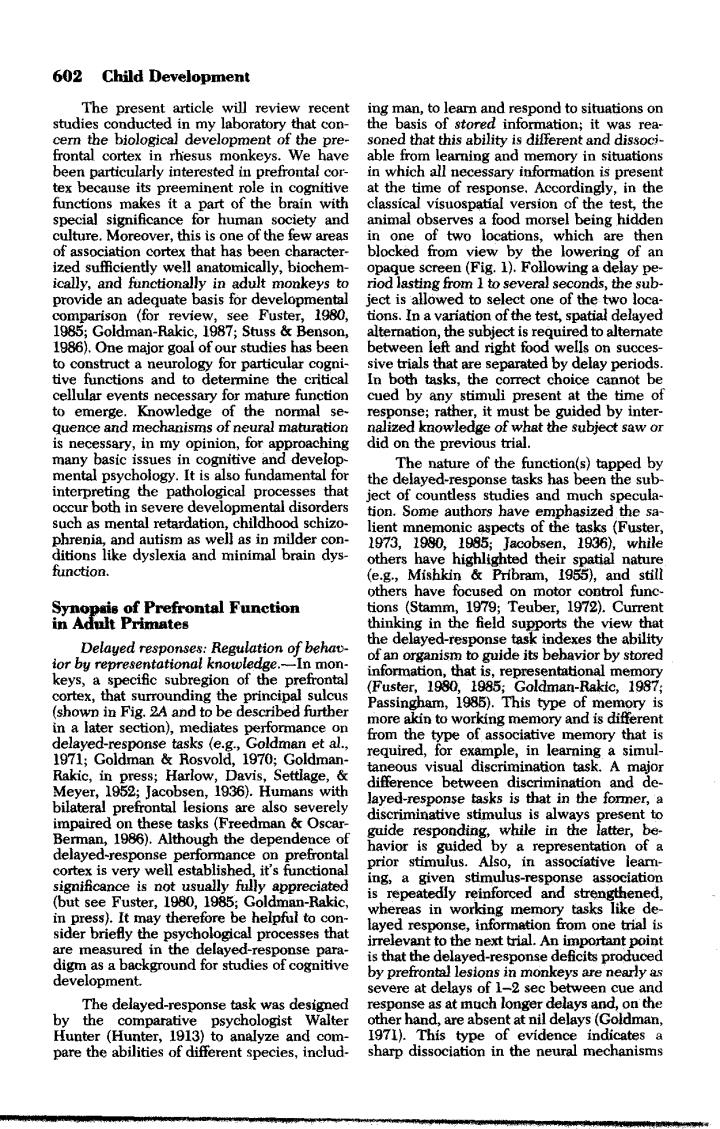正在加载图片...

602 Child Development The pr sent article will review recent nan,to learn and respond to situations or tud frontal cortex in rhesus m nkeys We able part in pretront cor the anima Sumcicnty weilanbas huma cter of an .1).Fo wing a d provide an ad quate basis loce Fu aye 19)Oe major has been to co onstnctaneooeaeiernanteherg vatepateper o光a o cued by 6 emerge. did on the previous trial. many basic The are of the function(s)tap ed by es thnt dehavedeponeic ks has been tion. hasized the sa al ratu FsteE dy brain other highlighted their 955,a 1972. Cu the view Delayed Regulatior ior by represe of an c ha Passin am. 1985). This type me ory i nse tasks (e.g ncet al. ore 197o:G0 simu e arlow also erely layed- ponse is that in 1). in the ad havior by a repre ciatic ap but see Fuster,1980,198 ep rethorced ogical processes that to the next trial.An in ceys are ere at spons hand,are absent at nil in the 602 Child Development The present article will review recent studies conducted in my laboratory that concern the biologica] development of the prefrontal cortex in rhesus monkeys. We have been particularly interested in prefironta! cortex because its preeminent role in cognitive functions makes it a part of the brain with special significance for human society and culture. Moreover, this is one of the few areas of association cortex that has been characterized sufficiently well anatomically, biochemically, and functionally in adult monkeys to provide an adequate basis for developmental comparison (for review, see Fuster, 1980, 1985; Goldman-Rakic, 1987; Stuss & Benson, 1986). One major goal of our studies has been to construct a neurology for particular cognitive functions and to determine die critical cellular events necessary for mature function to emerge. Knowledge of the normal sequence and mechanisms of neur^ maturation is necessary, in my opinion, for approaching many basic issues in cognitive and developmental psychology. It is also fundamental for interpreting the pathological processes that occur both in severe developmental disorders such as mental retardation, childhood schizophrenia, and autism as well as in milder conditions like dyslexia and minimal brain dysfunction. SynopolB of Prefirontal Function in Adult Primates Delayed responses: Regulation of behavior by representational knowledge.—In monkeys, a specific subregion of the prefrontal cortex, that surrounding the principal sulcus (shown in Fig. 2A and to be described further in a later section), mediates performance on delayed-response tasks (e.g., Goldman et al., 1971; Goldman & Hosvold, 1970; GoldmanRakic, in press; Harlow, Davis, Settiage, & Meyer, 1952; Jacobsen, 1936). Humans with bilateral prefrontal lesions are also severely impaired on these tasks (Freedman & OscarBerman, 19^). Aldiough the dependence of delayed-response performance on prefrontal cortex is very well established, it's functional signiiicance is not usually fully appreciated (but see Fuster, 1980, 1985; GoIdman-Raklc, in press). It may therefore be helpful to consider briefly the psychologicfd processes that are measured in the delayed-response paradigm as a background for studies of cognitive development. The delayed-response task was designed by the comparative psychologist Walter Hunter (Hunter, 1913) to analyze and compare the abilities of different species, including m£«i, to learn and respond to situations on the basis of stored infonnation; it was reasoned that this ability is different and dissociable from leaming and memory in situations in which all necessary information is present at the time of response. Accordin^y, in the classical visuospatial version of the test, the animal observes a food morsel being hidden in one of two locations, which are then blocked from view by the lowering of an opaque screen (Fig. 1). Following a delay period lasting from 1 to several seconds, the subject is allowed to select one of the two locations. In a variation of die test, spatial delayed alternation, the subject is required to altemate between lefl and right food wells on successive trials that are separated by delay periods. In bodi tasks, die correct choice cannot be cued by any stimuli present at the time of response; ra^er, it must be guided by internalized knowlec^e of what die subject saw or did on the previous trial. The nature of die function(s) tapped by the delayed-response tasks has been die subject of coundess studies and much speculation. Some authors have emphasized the salient mnemonic aspects of the tasks (Fuster, 1973, 1980, 1985; Jacobsen, 1936), while odiers have hi^i^te d their spatial nature (e.g., Mishkin & Pribram, 19^), and still others have focused on motor control fiinctions (Stamm, 1979; Teuber, 1972). Gurrent thinking in die field supports the view that die delayed-response task indexes the ability of an oi:ganism to guide its behavior by stored information, that is, representational memory (Fuster, 1^0, 1985; Goldman-Rakic, 19S7; Passins^iam, 1985). This type of memory is more akin to working memory and is diflferent from die type of associative memory diat is required, for example, in leaming a simultaneous visual discrimination task. A major difference between discrimination and delayed-response tasks is that in die former, a discriminative stimulus is always present to g^de respon&ng, while in the latter, behavior is guided by a representation of a prior stimulus. Also, in associative learning, a given stimulus-response asscxriation is repeatedly reinforced and strengthened, whereas in working memory tasks like delayed response, inform^on fiom one trial is irrelevant to the next trial. An importfuit jKiint is that the delayed-response deficits produced by prefrontaJ lesions in monkeys are nearly as severe at delays of 1—2 sec between cue and response as at much longer delays and, on the other hand, are absent at nil delays (Goldman, 1971). This type of evidence indicates a sharp dissociation in the neural mechanisms